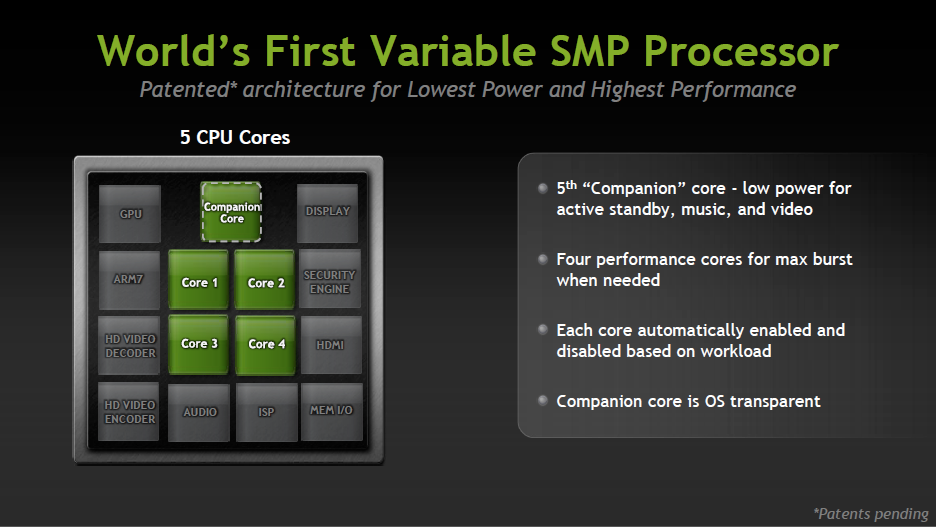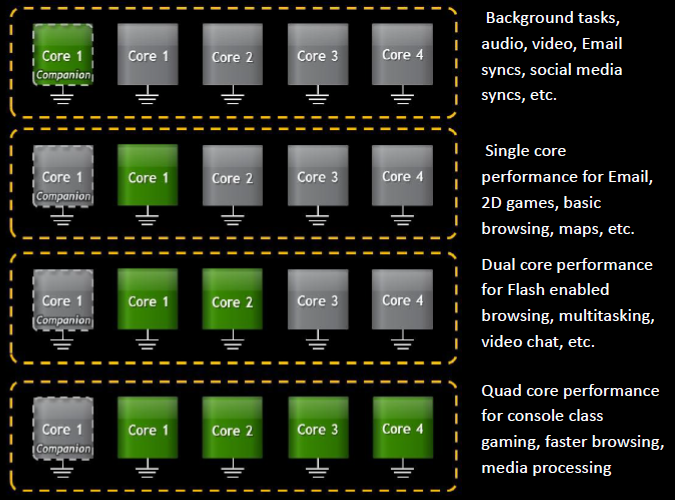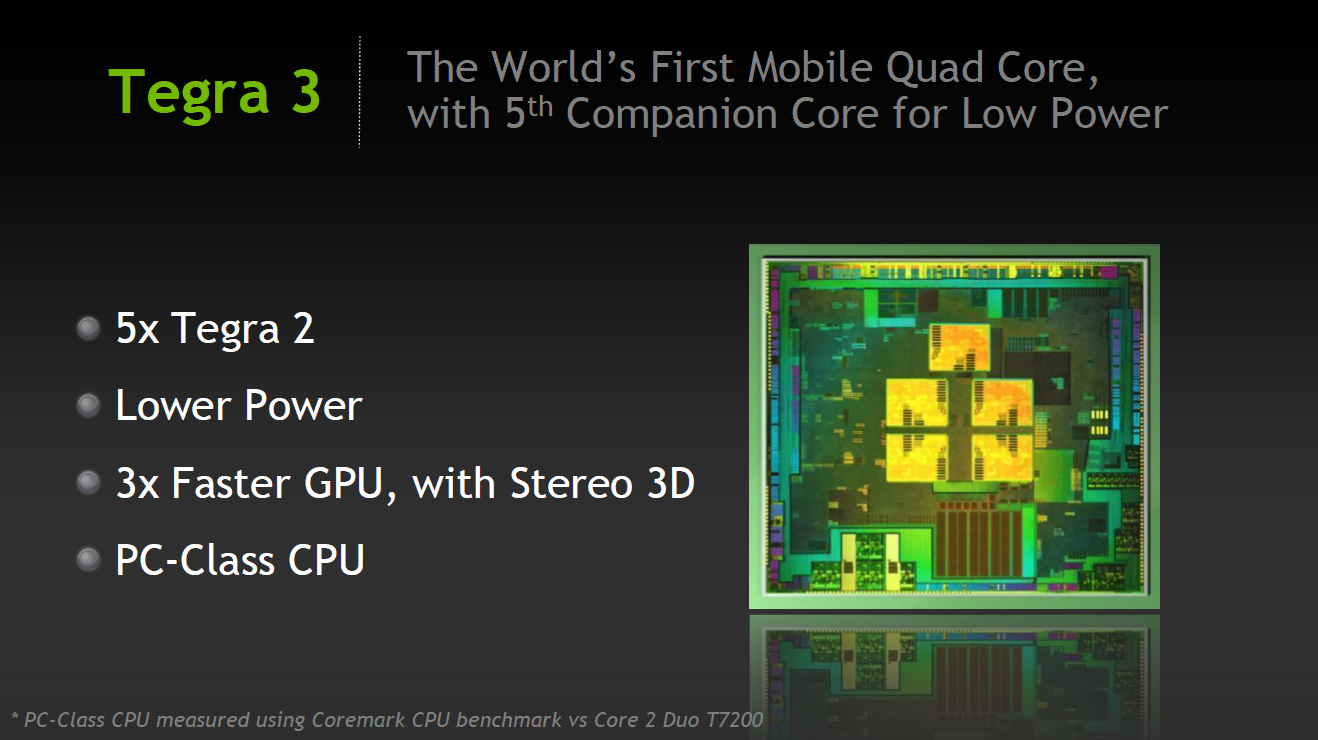Four plus one core for longer battery life
NVIDIA openly discussed bits on Tegra 3 earlier this fall and informed that the quad-core processor, actually had five cores. Considering how the technology works we can’t say it is worthy of being called a penta-core processor and NVIDIA agrees. The fifth core is there just to reduce energy consumption, which is one of the main ingredients of Tegra 3.
The fifth companion core
Tegra 3 houses a total of five ARM Cortex-A9 cores, but at most four can operate simultaneously. The fifth core is a companion that that is there for reducing energy consumption, using a technology NVIDIA calls vSMP (Variable Symmetric Multiprocessing), but vSMP can also change clock frequency dynamically on the four other cores – again for lower energy consumption.
 The fifth cores is built with LP transistors (Low Power) that are optimized for lower current leakage and thus lower energy consumption, but the drawback is lower frequencies, which is also part of the point of this. The companion core will run at low clock frequencies, with low energy consumption to handle easier takses and background applications. It is limited to 500 MHz. This is a better alternative than letting one core run at 1 GHz and up always run in the background drawing more energy.
The fifth cores is built with LP transistors (Low Power) that are optimized for lower current leakage and thus lower energy consumption, but the drawback is lower frequencies, which is also part of the point of this. The companion core will run at low clock frequencies, with low energy consumption to handle easier takses and background applications. It is limited to 500 MHz. This is a better alternative than letting one core run at 1 GHz and up always run in the background drawing more energy.
If we move over to the regular cores, built with normal GP transistors (General Purpose) and more leakage, but also potential for higher clock frequencies. This is the quad-core part of Tegra 3. The processor has variable clock frequencies that can change dynamically. When a single core is used it can go up to 1.4 GHz, while when two to four cores can operate at up to 1.3 GHz. Idle cores will be shut down using Power-gating.
| Cores | Clock frequency |
| Companion core |
Up to 500 MHz |
| One core |
Up to 1.4 GHz |
| Two to four cores | Up to 1.3 GHz |
The constant use of “up to” when we talk frequencies is another important part of the vSMP technology. NVIDIA has developed it to dynamically set the clock frequencies and voltages, also to save energy. Instead of discussing how it works, the video below shows how it works in practice and how Tegra 3 dynamically switches between its four cores, and the companion core.
vSMP is set up to accomplish two things: better performance, and lower energy consumption. What is really interesting with the technology is that it is completely transparent for the operating system all done in the hardware. NVIDIA’s Tegra 3 know when it is time to use the four ordinary cores, or the earker, but more efficient companion core. Neither operating system developers, or app developers need to worry about the technology, it will just work.
 NVIDIA are clear to point out that all five cores will never be active at the same time – ever. Either the fifth companion core, or the four normal cores will operate. This is not a problem, according to NVIDIA, as four cores is the “sweet spot” on the current market. With the nature of the technology in mind, it is more precise calling Tegra 3 for a quad-core system processor, and we should look at the companion core for what it really is – a sophisticated energy saving function.
NVIDIA are clear to point out that all five cores will never be active at the same time – ever. Either the fifth companion core, or the four normal cores will operate. This is not a problem, according to NVIDIA, as four cores is the “sweet spot” on the current market. With the nature of the technology in mind, it is more precise calling Tegra 3 for a quad-core system processor, and we should look at the companion core for what it really is – a sophisticated energy saving function.
NVIDIA first with four cores
NVIDIA will be first on the ultramobile market for tablets and smartphones with four cores. It is actually the only company with intentions f releasing a quad-core system processor at 40nm, and the other actors, such as Qualcomm and Texas Instruments, will not announce its quad-core solutions until 28nm is readyy next year.
What about software then? NVIDIA says the mobile market has adjusted much faster than earlier examples to multi-core support. This is because the mobile ecosystems (iOS, Android, Windows Phone, etc.) have started to adjust to performing tasks like in a PC environment.
Most developer kits are adjusted to multi-core and Android is built on Linux that is natively multi-core. Since the launch of Android 2.3, 3.0, 3.1, 3.2 and now 4.0 it has continuously improved the ability of the operating system to use the power of multiple cores, which is also demonstrated by the video above. NVIDIA is confident that its quad-core flagship will come to good use.
 Coremark is a benchmark developed for measuring processor performance and according to this Tegra 3 will be on level with Core 2 Duo T7200. The Intel processor is based on the Conroe architecture and sports two cores at 2.0 GHz. This is hardly world-class performance, but enough to cover the needs of most people – especially in a smartphone or tablet.
Coremark is a benchmark developed for measuring processor performance and according to this Tegra 3 will be on level with Core 2 Duo T7200. The Intel processor is based on the Conroe architecture and sports two cores at 2.0 GHz. This is hardly world-class performance, but enough to cover the needs of most people – especially in a smartphone or tablet.
Do note that these performance evaluations were done by Nvidia and only one synthetic benchmark, but should give us a hint of the capacity of Tegra 3. We will get a clear picture of performance when get to squeeze the first units.

















